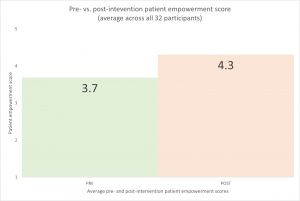“Alexa, start Get Well Safely” – Development of a learning video and a smart speech assistant quiz and evaluation of its effect on patient empowerment prior to an unplanned inpatient stay
Aim and Research Question(s)
The aim was to determine to what extent a learning video in combination with a smart speech assistant quiz can improve patient empowerment (PE) prior to an unplanned inpatient stay (due to a non-chronical disease).
Background
Fully trusting health professionals is not necessarily a bad thing, except when giving up self-responsibility in the process. Health outcomes can be improved by focussing on PE [1], e.g., by helping patients to engage in their recovery process. This issue was adressed using digital health technology.
Methods
The video and smart speech assistant quiz included general facts/questions about PE and patient safety tips, conveyed using “example”-patients. The video was created using the simpleshow videomaker & a neural voice from Amazon Polly.
 Image 1: Screenshot from the learning video
Image 1: Screenshot from the learning video
The quiz was designed with Voiceflow & the Alexa Skills Kit. Two questionnaires (developed based on earlier research), containing 18 statements to determine a PE score (on a five-point Likert scale) were handed out to 32 participants. They were asked to fill out the pre-intervention questionnaire, then watch/do the video & quiz as often as possible (within two weeks), before filling out the post-intervention questionnaire. The PE score was calculated using the participants’ mean response across all statements (min. 1, max. 5).
Results and Discussion
With an average pre-intervention PE score of 3.7 and an average post-intervention PE score of 4.3 (a plus of 0.6), a Wilcoxon Signed-Rank test showed that the hypothesis (h1) that the intervention does have an impact can be confirmed. The effect size being high with d = 0.9.
 Figure 1: Pre- vs. post-intervention PE scores
Figure 1: Pre- vs. post-intervention PE scores
There are limitations to the study, further research is needed. Whether e.g., the measured increase in the PE levels applies to “real life” and if the intervention causes long term effects that outlast the two-week survey period can not be determined.
Conclusion
A learning video combined with a smart speech assistant quiz appears to be a valuable way to convey health information and increase PE levels. Further research and (technical) developments will hopefully continue to contribute to increasing public health by (further) empowering patients. Meanwhile, the role of health-professionals and policymakers should not be forgotten as they too are part of the PE process.
References
[1] ‘Patient empowerment can lead to improvements in health-care quality’, Bull. World Health Organ., vol. 95, no. 7, pp. 489–490, 2017, doi: 10.2471/BLT.17.030717.